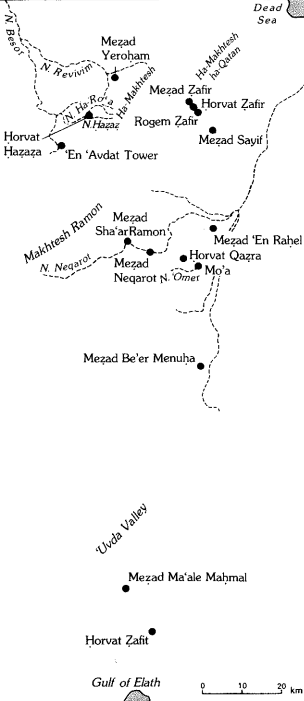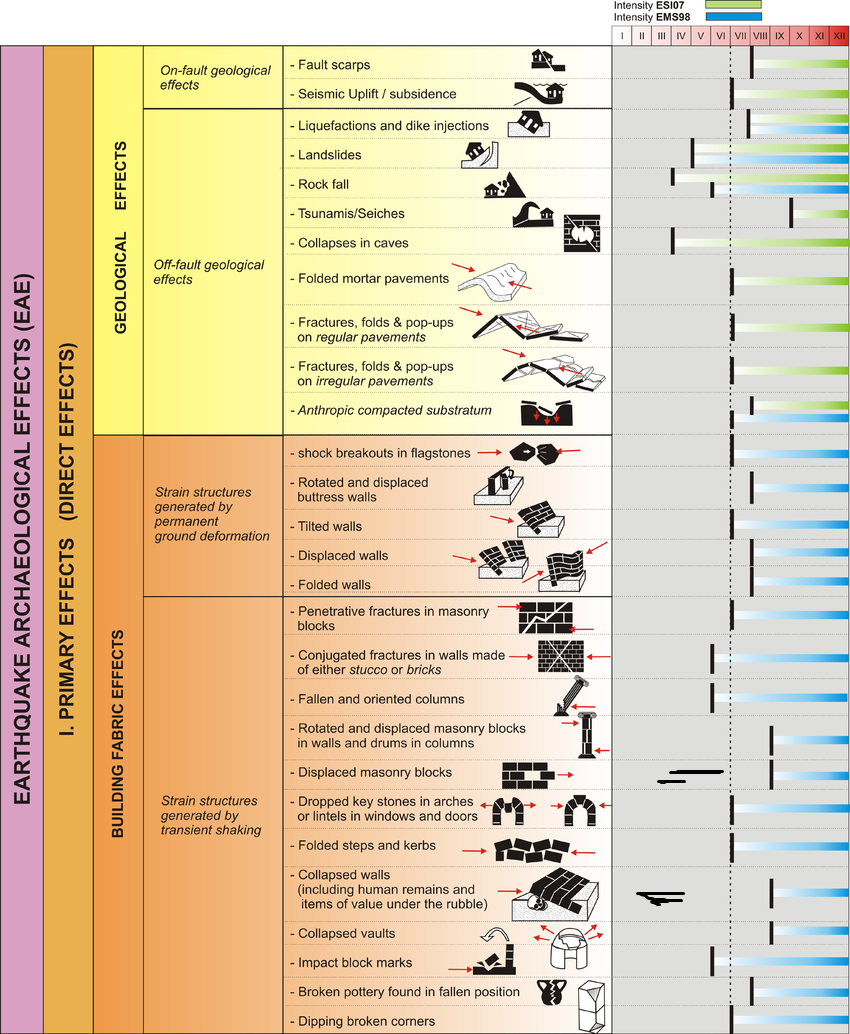Horbat Hazaza
Description
[Horbat Hazaza] is located 2.5 km northeast of the Haluqim Junction near Kibbutz Sede Boqer (map ref. 183376/534142) and [is] situated on a low hilltop overlooking the modern Sede Boqer—Yeroham Road 204 on the west and Nahal Ha-Ro`a and Nahal Hazaz on the east. The site was established next to an ancient track linking the Oboda/Sede Boqer region with the Nabatean site of Mampsis in the Classical period.
Description and Excavations
[Horbat Hazaza], a site on a low hill on Mount Haluqim, at the confluence of the Nahal ha-Ro'a and Nahal Hazaz riverbeds (map reference 134.034), was surveyed in 1953 by E. Anati and again, in 1965, by the Southern Survey team, under R. Cohen. A salvage excavation was conducted here in 1971 by Cohen, on behalf of the Israel Department of Antiquities and Museums. The excavations unearthed a structure built of ashlars (51 by 22 m), aligned northwest-southeast and comprising two attached wings: the main, northern wing (33 by 22m) and the southern wing (18 by 22m). Each had a separate entrance room leading to a central courtyard surrounded by rooms and halls. No communication was found between the two wings. Two levels of occupation were identified: an earlier level (stratum 2), from the first century CE, and an upper level (stratum 1), from the second to the fourth centuries CE
Maps, Aerial Views, and Plans
Maps
Normal Size
- Fig. 1 Location Map from
from Erickson-Gini (2019)

 Fig. 1
Fig. 1
Location map of the site and its surroundings
(©2019 all rights reserved by the Survey of Israel, printed with Survey of Israel permission)
Erickson-Gini (2019) - Location Map from
Stern et. al. (1993 v.3)

 Map of the main Hellenistic, Roman, and Byzantine sites in the Negev Hills
Map of the main Hellenistic, Roman, and Byzantine sites in the Negev Hills
Stern et. al. (1993 v.3)
Magnified
- Fig. 1 Location Map from
from Erickson-Gini (2019)

 Fig. 1
Fig. 1
Location map of the site and its surroundings
(©2019 all rights reserved by the Survey of Israel, printed with Survey of Israel permission)
Erickson-Gini (2019) - Location Map from
Stern et. al. (1993 v.3)

 Map of the main Hellenistic, Roman, and Byzantine sites in the Negev Hills
Map of the main Hellenistic, Roman, and Byzantine sites in the Negev Hills
Stern et. al. (1993 v.3)
Aerial Views
Plans
Normal Size
- Site Plan & Section
from Erickson-Gini (2019)

 Plan 1
Plan 1
Site Plan and Section
Erickson-Gini (2019)
Magnified
- Site Plan & Section
from Erickson-Gini (2019)

 Plan 1
Plan 1
Site Plan and Section
Erickson-Gini (2019)
Phasing
- from an excavation in 2001 as reported by Erickson-Gini, T. (2019)
| Phase | Start Date Centuries CE |
End Date Centuries CE |
Description |
|---|---|---|---|
| 1 | 2nd half of 1st | Early 2nd | This phase is Nabataean and may be dated to the Early Roman period (prior to the Roman annexation in 106 CE), i.e., the second half of the first through the early second centuries CE. |
| 2 | Early 2nd | 3rd | Phase 2 commenced when the north wing was restored and expanded following earthquake damage in the early second century CE and corresponds with the second, post-annexation phase of occupation (post-106 CE). Domestic use of the courtyard (Room 30) appears to indicate that the structure ceased to function as a temple sometime during the second century CE. This phase extends primarily through the second and third centuries CE. |
| 3 | 4th - mid 5th | Phase 3 is represented by a minor amount of material in one corner of the courtyard (Room 30) as late as the Early Byzantine period (fourth to mid-fifth centuries CE). |
South Wing Earthquake - Early 2nd century CE
Plans
Normal Size
- Site Plan & Section
from Erickson-Gini (2019)

 Plan 1
Plan 1
Site Plan and Section
Erickson-Gini (2019)
Magnified
- Site Plan & Section
from Erickson-Gini (2019)

 Plan 1
Plan 1
Site Plan and Section
Erickson-Gini (2019)
Discussion
Notes by JW
Erickson-Gini (2019:152,167) reports destruction of the South Wing and subsequent abandonment along with three fallen arches in Room 2. A 1st century CE terminus post quem was established for the fallen arches based on Nabatean pottery and a terminus ante quem seems to have been established due to continued occupation of the north wing where pottery as early as the first half of the 2nd century CE was found (Hayes’ Form P40 fine-ware krater - Erickson-Gini, 2019:162).
Room 2 had previously been excavated down to floor level by Cohen in 1971, revealing three fallen arches, laying in situ. In the present excavation, two of these arches were removed and the soil below them (L501), which was excavated down to bedrock, was sieved completely. Although scant material remains were found in the level below the floor, sherds of Nabatean painted-ware bowls (Fig. 12:2, 5, 13) appeared, with painted decoration of the 1st century CE.
... The new evidence from the 2001 excavations at the site indicates that it was established in the mid-first century CE, during Nabatean rule over the area. The material discovered in the south wing, together with evidence of the fallen arches in Room 2, point to its destruction and subsequent abandonment of the south wing sometime in the early second century CE, after which it may have been stripped of its building stones. In contrast, the north wing was rebuilt and continued to be partially occupied well into the post-annexation period (Phase 2; second—third centuries CE) and early Byzantine period (Phase 3; fourth—mid-fifth centuries CE). The event that damaged the structure may be the same earthquake detected at several other sites in the central Negev and ‘Arava Valley, including an early structure next to Meẓad Ma‘ale Maḥmal, excavated by the author in May 2004, and Meẓad ‘En Raḥel, excavated in 1981 by Nahlieli and Israel (1981:35; Korjenkov and Erickson-Gini 2003) and an early Nabataean structure investigated next to ‘En Yoṭvata by the author in 2005 and 2006. Structural collapse, as well as damage and repairs, probably caused by the same earthquake event, have been detected in southern Jordan at Khirbat et-Tannûr (Glueck 1938:13; 1965:521), Khirbat ed-Darih (Roller 1983:180), ‘Aqaba (Dolinka 2003:30–32, Fig. 14) and Petra (Joukowsky and Basile 2001:50; Kolb 2002:260–261; 2007:167).
South Wing Earthquake - Early 2nd century CE
| Effect | Location | Image(s) | Description |
|---|---|---|---|
| Destruction | south wing
 Plan 1
Plan 1Site Plan and Section Erickson-Gini (2019) |
|
|
| collapsed arches | Room 2
 Plan 1
Plan 1Site Plan and Section Erickson-Gini (2019) |
|
South Wing Earthquake - Early 2nd century CE
- Modified by JW from Plan 1 of Erickson-Gini (2019)
 Deformation Map
Deformation MapModified by JW from Plan 1 of Erickson-Gini (2019)
South Wing Earthquake - Early 2nd century CE
-
Earthquake Archeological Effects chart
of Rodríguez-Pascua et al (2013: 221-224)

 Earthquake Archeological Effects (EAE)
Earthquake Archeological Effects (EAE)
Rodríguez-Pascua et al (2013: 221-224)
| Effect | Location | Image(s) | Description | Intensity |
|---|---|---|---|---|
| Destruction - collapsed walls ? | south wing
 Plan 1
Plan 1Site Plan and Section Erickson-Gini (2019) |
|
VIII+ ? | |
| collapsed arches | Room 2
 Plan 1
Plan 1Site Plan and Section Erickson-Gini (2019) |
|
VI + |
References
Articles and Books
Bibliography from Stern et. al. (1993 v.3)
Musil, Arabia Petraea 2, 207-208
N. Glueck, AASOR !5 (1935), 17-20
F. Frank, ZDPV
57 (1934), 254.

